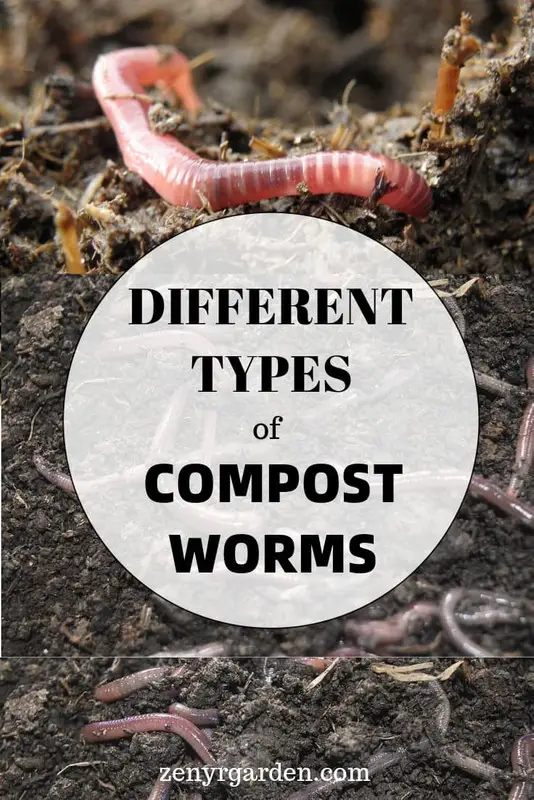Let's compare some different types of composting worms together. If you're looking to make your compost with worms, then don't go with earth worms. They are more for aerating the dirt and are not as efficient for breaking down organic matter.
With that said, let's start with the first type of compost worm, which is also a great one for beginners.
#1. Red Wigglers (Red Worms)
Red wigglers are one of the easiest worms to begin with if you're just starting out with composting. They are very forgiving so you can feel more comfortable making mistakes and don't have too worry too much about killing them.
Regarding size, these guys are very small and thin. They are much smaller than earth worms and the other types of worms. When they are still a baby, you won't see a little band around their bodies. When they are mature enough, they will develop a band around them, which is a sign to tell they are now an adult.
Red wigglers are less sensitive to environmental changes than blue worms. Meaning, when there's a storm coming or some changes in the barometric pressure (atmospheric pressure), these guys won't get too panicked and start climbing up out of the bin all at once.
About a pound (450 gram) of food per week would be good enough for them. These red wigglers are not the most voracious eaters in the worm kingdom. But they produce one of the richest worm castings (worm poop) that many gardeners call black gold. For about 11 lbs (5 kg) of red worms, you may get about 2.2 lbs (1 kg) of castings within 3 months.
And these guys double their population every 60-90 days. So you can imagine how much worms and castings you could end up with from a small 1000, 2000 or a pound (450 gram) of worms on good growing conditions.
Overall, this is a very good all-around type of worms for every raiser at any skill levels.
The next one you might want to see is:
#2. Blue Worms
Blue worms move a lot faster than red worms. They inch forward somewhat like the movement of a caterpillar. These guys are another great composter. Under ideal conditions, they may do even better than the red wigglers.
The adult clitellum (or the band or the ring around their body) of blue worms doesn't bulge quite that much like the red worms do when the worms scrunched up. It is more inline with the rest of their body and has a lighter color.
One downside of blue worms that disappoints quite a lot of people is that they are temperamental to atmospheric pressure changes. So when there's a storm coming, they may climb up the bin to seek for higher ground. Worm escaping may not be a fun thing that you'd want for your worm bin.
#3. European Nightcrawlers
The Euros are substantially longer than the other worms. You can tell them apart by the distinctive stripes on the bodies. The ring on their bodies has a shorter distance to the worm's moving head than the tail.
Euros are also a great composter. They don't produce quite as fast as the red and blue worms, especially during the winter months. But they do make great fishing worms as they are quite meaty and thick.
The next type of worm you might want to explore is:
#4. African Nightcrawlers
African nightcrawlers eat like crazy and also reproduce like crazy. It's like no one can stop them. While the other types of worms eat about half their body weight a day, African nightcrawlers can eat up to 1.5 to 2 times their weight a day.
So if a weekly amount of food for the red worms is about 1 lb (450 grams), for these guys it's more about 1-3 lbs (450 gram to 1.3 kg) per week.
African nightcrawlers are also very very long. They could get up to a foot long if their body is all flexed out. When put under a light source, their skin reflects a purple sheen to it. They like a warmer tropical environment and can produce hundreds of cocoons in such environment.
This one is typically not recommended as a beginner worm because it requires some maintenance. You may need to swap out and replace the bedding for them more often than the other worms. They do like some carbon-rich materials.
Have you also seen these:
#5. Tiger Worms
Tiger worms are very big, thick worms. In the natural environment, they usually live around areas with very fertile and moist soil or under the base of banana plants.
Unlike the red wigglers which consume more organic stuff, these guys help break down the minerals in the soil. They eat in the vertical straight direction and not the horizontal direction like the red worms.
Tiger worms can't tolerate too much water; they like it moist but not too soggy.
/tiger-worm-collage.jpg)
Also, these guys move fast and are pretty slimy:
/tiger-worm-close-up.jpg)
From some raisers' experience, tiger worms don't seem to like contained spaces. They like to explore the area around more freely. Tiger worms do make good compost. And because they are large, they consume well and are easier to spot and separate from the compost.
>> Link YouTube:
Constructing A Tiger Worm Bin To Produce Worm Castings And Worm TeaFinal Worms Comparison Table
| Worm | Scientific Name | Cocoons per week | Length | Days to mature |
|---|---|---|---|---|
| Red wigglers | Eisenia Andrei | 3-4 | 3-4 | 80-150 |
| Blue worms | Perionyx excavatus | 22 | 3-4 | 40-60 |
| European Nightcrawlers | Eisenia hortensis | 1-2 | 5-7 | 100-200+ |
| African Nightcrawlers | Eudrilus eugeniae | 3-4 | 8+ | 40-100 |
| Tiger worms | Eisenia fetida | - | 5-10 | - |
Credits:
Explore more worm post here:
Share or pin this post!


